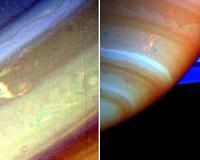 |
Pasadena, Calif. (UPI) Nov 26, 2010 NASA's Cassini space probe orbiting Saturn has found evidence of an atmosphere on Rhea, one of the ringed planet's moons, U.S. researchers say. The spacecraft has detected a very thin atmosphere containing oxygen and carbon dioxide around the icy moon, a NASA release said Friday. This marks the first instance of a spacecraft directly capturing molecules of an oxygen atmosphere -- admittedly a very thin one -- at a world other than Earth, scientists said. The formation of oxygen and carbon dioxide, as detected on Rhea, could possibly drive complex chemistry on the surfaces of many icy bodies in the universe, researchers say. "The new results suggest that active, complex chemistry involving oxygen may be quite common throughout the solar system and even our universe," Ben Teolis, a Cassini team scientist based at Southwest Research Institute in San Antonio, said. "Such chemistry could be a prerequisite for life," he said. But, he added, "All evidence from Cassini indicates that Rhea is too cold and devoid of the liquid water necessary for life as we know it." The oxygen and carbon dioxide atmosphere makes Rhea, Saturn's second-largest moon, unique in the Saturnian system. The planet's largest moon, Titan, has a thick nitrogen-methane atmosphere but very little carbon dioxide and oxygen. "Rhea is turning out to be much more interesting than we had imagined," Linda Spilker, Cassini project scientist at NASA's Jet Propulsion Laboratory in Pasadena, Calif., said. "The Cassini finding highlights the rich diversity of Saturn's moons and gives us clues on how they formed and evolved."
Share This Article With Planet Earth
Related Links Explore The Ring World of Saturn and her moons Jupiter and its Moons The million outer planets of a star called Sol News Flash at Mercury
 Saturn Then And Now: 30 Years Since Voyager Visit
Saturn Then And Now: 30 Years Since Voyager VisitPasadena CA (JPL) Nov 15, 2010 Ed Stone, project scientist for NASA's Voyager mission, remembers the first time he saw the kinks in one of Saturn's narrowest rings. It was the day the Voyager 1 spacecraft made its closest approach to the giant ringed planet, 30 years ago. Scientists were gathering in front of television monitors and in one another's offices every day during this heady period to pore over the bewildering ... read more |
|
| The content herein, unless otherwise known to be public domain, are Copyright 1995-2010 - SpaceDaily. AFP and UPI Wire Stories are copyright Agence France-Presse and United Press International. ESA Portal Reports are copyright European Space Agency. All NASA sourced material is public domain. Additional copyrights may apply in whole or part to other bona fide parties. Advertising does not imply endorsement,agreement or approval of any opinions, statements or information provided by SpaceDaily on any Web page published or hosted by SpaceDaily. Privacy Statement |